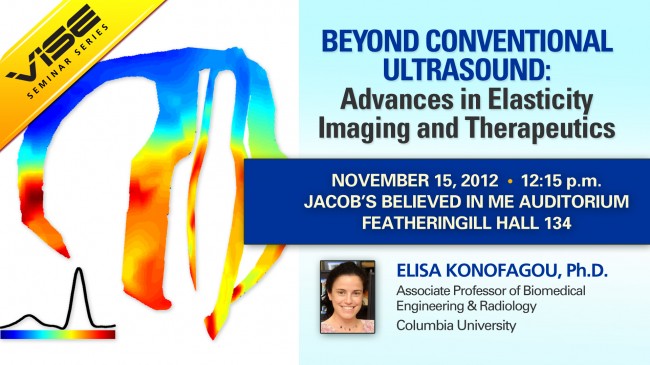ViSE Seminar – Beyond Conventional Ultrasound: Advances in Elasticity Imaging and Therapeutics; November 15th, 12:15PM, Jacobs Believed in Me Auditorium (FGH 134)
ABSTRACT
Elasticity imaging techniques aim at the detection of tissue abnormalities following an external, internal or inherent mechanical stimulation. By taking advantage of the additional depth information provided by ultrasound imaging, the local tissue response (i.e., displacement, strain and/or vibration amplitude) that depends on its mechanical properties can be imaged. After introducing methods for 2D and 3D strain estimation, examples will be shown on imaging of normal and pathological myocardium in finite-element models and in vivo murine, canine and human subjects. Additional elasticity imaging techniques, such as Pulse Wave Imaging for the characterization of abdominal aortic aneurysms in vivo and Electromechanical Wave Imaging for the assessment of the conduction properties of the myocardium, will also be discussed.
In the second part of this lecture, therapeutic ultrasound techniques will be introduced together with application of elasticity imaging for simultaneous monitoring of the treatment procedures. Most precisely, Focused Ultrasound (FUS) for ablation of tumors substantially modifies the stiffness of the tissue being treated in order to annihilate the function of the latter. By monitoring this stiffness change, the radiation-force-based Harmonic Motion Imaging (HMI) technique can successfully detect the temperature rise and coagulation onset during treatment. As a result, an all ultrasound-based system providing simultaneous tumor detection and treatment application as well as monitoring can be developed. Applications of such a system in both in vivo breast tumor ablation and opening of the blood-brain barrier (BBB) for brain drug delivery in mice will be shown. In conclusion, elasticity imaging techniques, whether applied using an external or internal mechanical stimulus, can provide important complementary information to ultrasonic imaging in applications ranging from cancer and cardiovascular disease detection to thermal therapy monitoring; reinforcing, thus, the role of ultrasonic imaging in medical diagnosis and treatment.


